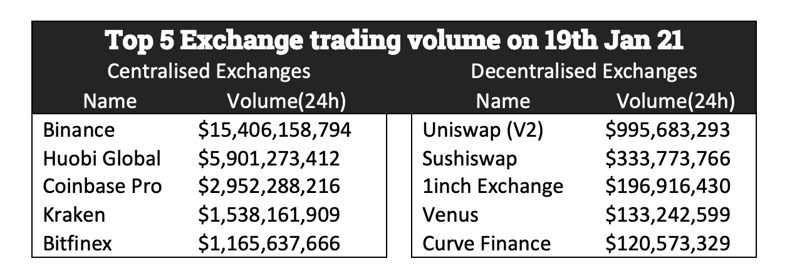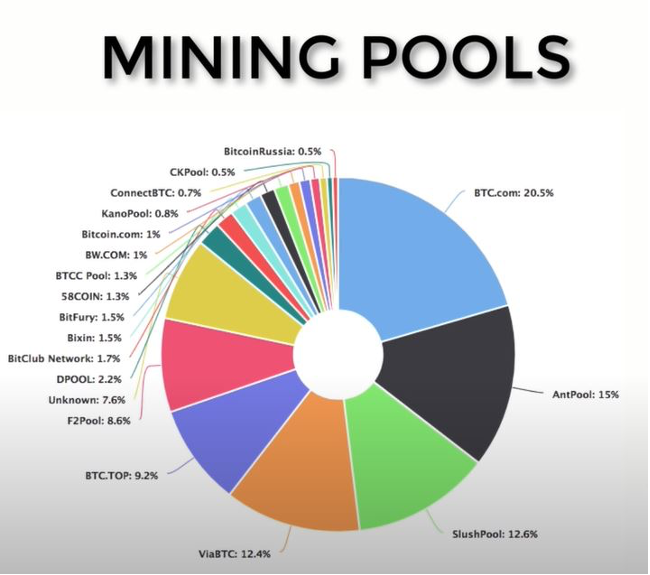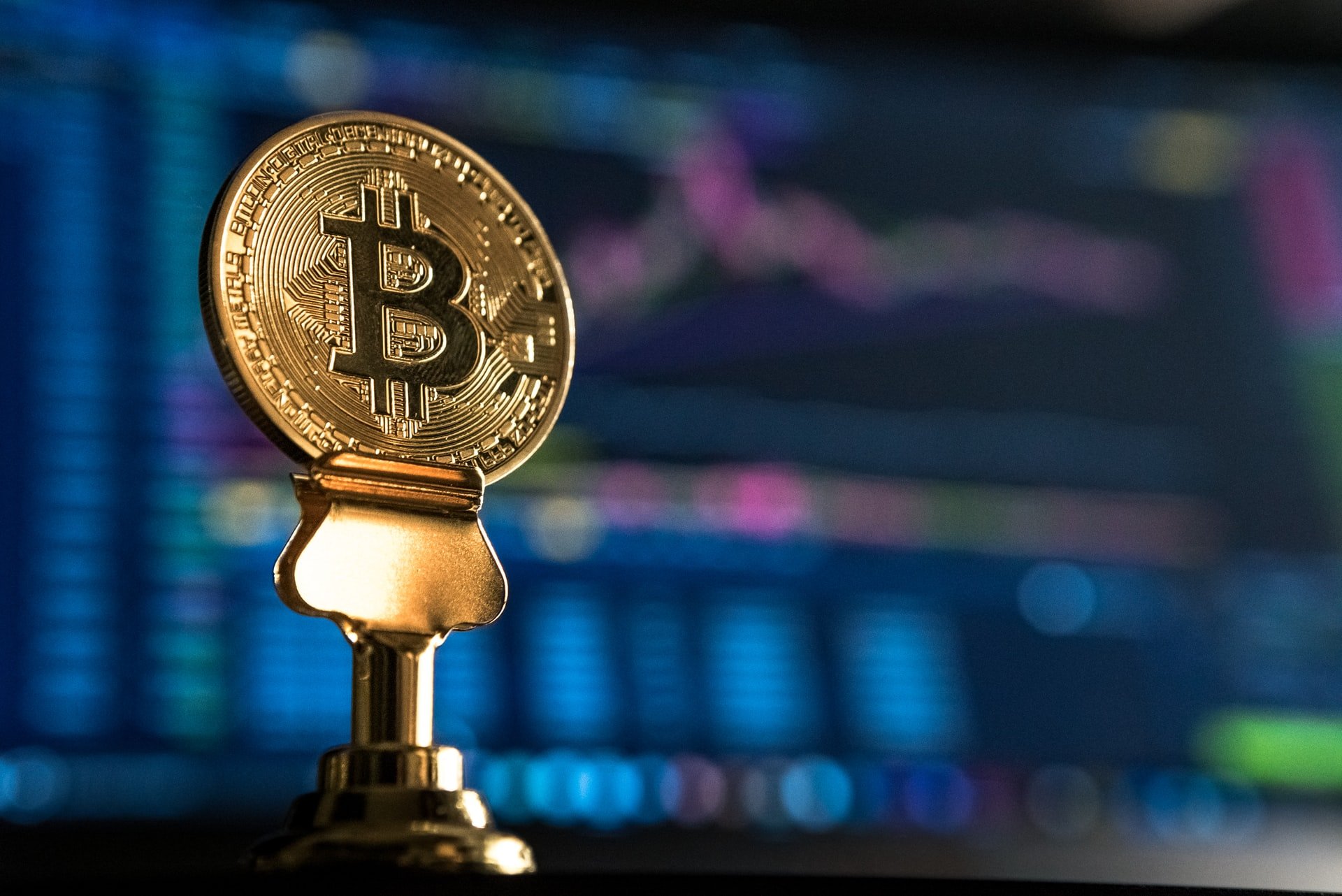Bitcoin broke through the $40,000 mark at the beginning of 2021 so we thought it timely to analyse the state of the cryptocurrency markets. This article provides a basic breakdown of:
- Cryptocurrencies
- Trading Exchanges, volumes and instruments
- Market participants
- Evolution of Bitcoin, Blockchain and Mining.
How many digital currencies are there?
The number of digital currencies has exploded. Needless to say, the majority of the 2,000 currencies out there are superfluous for the evolution of crypto assets and tend to be Bitcoin but with a slight gimmick or tweak. We have focused on the top 5.

Who are the major trading exchanges and what is traded?
There are two types of exchange; centralised and decentralised.
- Centralised exchanges take place off the Blockchain i.e. you open an account and the exchange has custody of your balance. This means you can trade frequently with other users in the exchange without the delay of blockchain processing, however, it does mean that you suffer counterparty risk.
- Decentralised exchanges are essentially a peer to peer marketplace for exchange and are executed on the blockchain.

The majority trading of crypto is against a FIAT currency (a government-backed currency) however the range of instruments has ballooned with many of the usual instruments you would find on an FX market available. This includes options, futures, swaps and index products as well as some more unique crypto assets like Crypto Tokens. Tokens reside on their own blockchain and are usually tied to physical assets or utility although they can also be linked to a cryptocurrency with a payout based on a smart contract (similar to a structured product). Ethereum is the most popular platform for raising tokens through an ICO (Initial Coin Offering).
Who has a crypto trading desk?
The largest player in Crypto from the trading world is arguably DRW. They set up Cumberland in 2014 and have progressed from proprietary trading to market-making and index formation (Cumberland Liquid Prime Crypto Asset Index)
Other trading firms that have set up Digital Desks include:
- Jump Trading
- Susquehanna
- Akuna Capital
- Flow Traders
- CMT Capital
- Jane Street
- Hudson River Trading
This list is only likely to expand with a few obvious trading firms missing from this list. It's only a matter of time before they enter the Frey.
Where it all began
In 2008, a paper titled Bitcoin: A Peer-to-Peer Electronic Cash System was published by a pseudonym author, Satoshi Nakamoto. The paper proposed an innovative way to solve the problem of trust in a decentralised digital currency, namely a blockchain. A blockchain is a decentralised ledger that is maintained by all the network participants.
The first digital currency created was Bitcoin. Every bitcoin in circulation is included in the blockchain ledger and attributable to an address (account balance). The current number of bitcoin in circulation is 18,604,593.75 (equivalent to roughly USD 692 billion at today's market price). Bitcoins are stored in digital wallets, which contain the public and private keys associated with your bitcoins. The private key is essentially your PIN and acts as a digital signature whilst the public key is similar to your account number.
How do bitcoin transactions work?
To make a payment in Bitcoin you need the address of the recipient's wallet and your own public and private key to validate the transaction. You enter the transaction details, amount, addresses and a transaction fee (we will explain further in next paragraph) and broadcast to the bitcoin network where it will reside in the memory pool (Mempool) which is the database of all unconfirmed transactions.
How are transactions confirmed?
The blockchain is a distributed ledger i.e. the ledger is held by all nodes (Miners) in the network. A node is essentially a computer that holds all the blockchain transactions. Each node competes with the other nodes to process the unconfirmed transactions in the Mempool. Transactions are grouped into blocks no bigger than 1MB. Each block contains validated transactions (i.e. valid digital signatures, amounts etc) and a cryptographic hash. The hash is described in an accompanying proof of work and only valid proof of works are accepted by the network.
What is proof of work?
In order to generate a new block in the chain, miners require 6 pieces of information which are included in the new block's header.
The version number of the software
The software version number does not matter in most cases. However, a miner with a particular version number can signal which protocol decisions he supports.
The hash of the previous block
This is the link in the chain to the previous ledger which provides the chronology and makes editing historical transactions almost impossible
The root hash of the Merkle tree
All the transactions in the block are run through an algorithm to produce a transaction hash. These are then concatenated and hashed together and so on until there is one hash for the entire block, the root hash.
The time in seconds since 1970–01–01 T00: 00 UTC
A timestamp
The goal of the current difficulty
The difficulty target changes every 2016 blocks, roughly two weeks, based on the number of nodes in the network. If there are more nodes i.e. compute power, the difficulty will go up and vice versa, fewer nodes the difficulty level will go down.
The nonce
A random 32-bit number
Miners sequentially try to find the nonce. This race is called the Hashrate i.e. the number of attempts per second to find the nonce. The repetitive nature and complexity of this work demand significant compute power. This has meant hashing has evolved from using CPUs, to GPUs, to FPGAs and now ASICs (application-specific integrated circuit). One ASIC on its own is unlikely to find the nonce, so firms have sprung up that pool your ASIC with other ASICs to solve the problem.
The miner that finds a nonce that produces a hash value equal to or less than the network's difficulty target can then build a new block. This block is broadcast to the rest of the network. The new hash can be easily verified by the rest of the network through a validation algorithm.

What's in it for the miners?
The miner, or pool of miners, that broadcast a block with a valid proof of work wins the race and receive a mining reward (currently 6.25 Bitcoin) plus fees for all the transactions in the block. The transactions in that block are now in the chain and the process starts again for the other unconfirmed transactions in the mempool.
Theoretically, transactions are free on Blockchain, but to encourage miners to include your transaction in their block, a fee is normally added. Transaction fees fluctuate, but in dollar terms average out at roughly $10. If you are part of a pool, the reward and transaction fees are split based on how much compute power you contribute to the pool.
Who pays the mining reward?
The maximum amount of bitcoins in circulation is fixed in the blockchain at 21,000,000. The total number of bitcoins in circulation is 18,604,593.75 meaning there are nearly 2.4 million bitcoins still to be mined. Please note, Bitcoins can only be created through mining. No central body, bank or government can mine new Bitcoin. The reward for mining bitcoins is halved after every 210,000 blocks, which is roughly every four years and serves as an inflation of the market price thus continuing to incentivise the miners. The most recent halving was in May 2020 and based on current expectations the final bitcoin will be mined in 2140.


